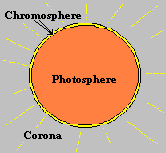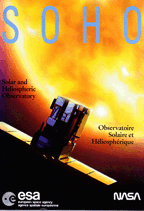The Sun's Corona

Of all the billions and billions of stars in the Universe, only one small and fairly unremarkable star really matters to us: the star without which life would be very different on Earth -- our star, the Sun.
Because of its proximity, the Sun is one of the most studied stars, but it has not yet revealed all its secrets.

One of the most puzzling features of the Sun is what has been dubbed "the solar corona problem." There is a region around the Sun, extending more than one million kilometers from its surface, where the temperature can reach two million degrees. This region, called the solar corona, is where the solar wind originates. The corona has been found to emit X-ray radiation (the corona is a plasma; at temperatures greater than a million degrees a plasma will radiate a lot of X-rays). The corona can be seen only during solar eclipses, when the main radiation from the Sun's surface is blocked by the passage of the Moon or with special instruments.

The problem is, no one can really explain how this corona exists. Even if the temperature in the core of the Sun does reach 15 million degrees, it drops to a mere 5000 degrees at the surface. The temperature should be even lower farther away from the Sun, but the temperature of the corona is measured at more than a million degrees. This incredibly hot temperature requires a permanent heating mechanism, or the plasma would cool down in about an hour. There are many mechanisms which could heat some gas above the surface of the Sun, but none of those mechanisms could account for the large rate of heating necessary to heat the corona to these temperatures. This phenomenon remained a mystery for more than 50 years.

Things have changed. Although the details of the answer are not completely known, it does seem that the solution is near.
Using data from instruments onboard the SOlar and Heliospheric Observatory (SOHO) and from the more recent Transition Region And Coronal Explorer (TRACE), solar physicists have identified small patches of magnetic field covering the entire surface of the Sun. Contrary to the bright, large magnetic field loops which are linked to the "active regions" during periods of solar maxima, these patches seem to appear and disappear randomly in time scales on the order of 40 hours. Scientists now think that this magnetic carpet is probably a source of the corona's heat.

According to Joseph Gurman, an astrophysicist at the Laboratory for Astronomy and Solar Physics at the Goddard Space Flight Center, people already suspected that magnetic fields were playing an active role in the Solar Corona problem. They thought the heat energy was coming from the active regions, where the spectacular giant loops are seen in Ultra-Violet and X-rays. But there was a problem with that theory: those giant loops disappeared during solar minima, while the corona does not.
Now most scientists believe that the heating of the corona is linked to the interaction of the magnetic field lines radiating out of the small patches mentioned above. Because the laws of electromagnetism prohibit the intersection of two magnetic field lines, every time magnetic field lines come close to crossing they are "rearranged," and this magnetic reconnection continuously heats the solar corona. It's a faily inefficient source of energy, but the sheer number of these small magnetic patches on the surface of the Sun makes the process a viable solution to the 50 year old problem of what heats the solar corona.
All is not quite clear yet. No one has directly observed any magnetic field reconnection. Experts do not even agree on the approximate length of time these patches remain active. As a direct consequence of this theory, the heating process should occur much closer to the surface of the Sun than previously thought, but no one really knows how close. "We need to find proofs that (magnetic reconnection) is really the story" says Gurman. One proof could be plasma jets, which scientists expect to be produced by the reconnection process. They've observed the jets before, but there were unfortunately too few observations to get conclusive evidence.

Also, no one really knows what could produce these magnetic patches, which vary on such short timescales. Professor Edward Spiegel from Columbia University has suggested that the patches are produced by small dynamos located just beneath the surface of the Sun. But once again, no one has any definitive proof of the theory.
The future of solar physics now resides in a better understanding of the magnetic reconnection phenomena and in future missions -- including a "Reconnection Microscope" devoted to the magnetic reconnection problem. The problems are very complex, but as Gurman pointedly notes, "If the Sun didn't have a magnetic field, it would be as boring as many astronomers believe it is".


